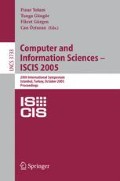Abstract
Tracking free form objects by fitting algebraic curve models to their boundaries in real-time is not feasible due to the computational burden of fitting algorithms. In this paper, we propose to do fitting once offline and calculate an algebraic curve space. Then, in every frame, algebraic curves from the search region of curve space are evaluated with the extracted edge points. The curve that has the smallest error according to some error metric is chosen to be the fit for that frame. The algorithm presented is for tracking a free-form shaped object, moving along an unknown trajectory, within the camera’s field of view (FOV). A discrete steady-state Kalman filter estimates the future position and orientation of the target object and provides the search area of curve space for the next frame. For initialization of the Kalman filter we used the “related points” extracted from the decomposition of algebraic curves, which represent the target’s boundary, and measured position of target’s centroid. Related points undergo the same motion with the curve, hence can be used to initialize the orientation of the target. Proposed algorithm is verified with experiments.
Access this chapter
Tax calculation will be finalised at checkout
Purchases are for personal use only
Preview
Unable to display preview. Download preview PDF.
References
Gibson, C.G.: Elementary geometry of algebraic curves. Cambridge University Press, Cambridge (1998)
Unel, M., Wolovich, W.A.: On the construction of complete sets of geometric invariants for algebraic curves. Advances in Applied Mathematics 24(1), 65–87 (2000)
Unel, M., Wolovich, W.A.: A new representation for quartic curves and complete sets of geometric invariants. International Journal of Pattern Recognition and Artificial Intelligence (December 1999)
Taubin, G., Cooper, D.B.: 2D and 3D object recognition and positioning with algebraic invariants and covariants. In: Symbolic and Numerical Computation for Artificial Intelligence, ch. 6. Academic Press, London (1992)
Keren, D., et al.: Fitting curves and surfaces to data using constrained implicit polynomials. IEEE Transactions on Pattern Analysis and Machine Intelligence 23(1) (January 1999)
Civi, H., Christopher, C., Ercil, A.: The Classical Theory of Invariants and Object Recognition Using Algebraic Curve and Surfaces. Journal of Mathematical Imaging and Vision 19, 237–253 (2003)
Tasdizen, T.: Robust and Repeatable Fitting of Implicit Polynomial Curves to Point Data Sets and to Intensity Images. PhD Thesis, Brown University, Providence, RI 02912 (September 2000)
Wolovich, W.A., Unel, M.: The determination of implicit polynomial canonical curves. IEEE Transactions on Pattern Analysis and Machine Intelligence 20(10), 1080–1089 (1998)
Frank, T., Haag, M., Kollnig, H., Nagel, H.-H.: Tracking of occluded vehicles in traffic scenes. In: 7th European Conference on Computer Vision, Cambridge, pp. 485–494. Springer, Heidelberg (April 1996)
Deriche, R., Faugeras, O.: Tracking Line Segments. Image and Vision Computing 8(4), 261–270 (1990)
Mitiche, A., Bouthemy, P.: Computation and analysis of image motion: a synopsis of current problems and methods. International Journal of Computer Vision 19(1), 29–55 (1996)
Blake, A., Curwen, R., Zisserman, A.: A framework for spatio-temporal control in the tracking of visual contours. International Journal of Computer Vision 11(2), 127–145 (1993)
Kottke, D.P., Sun, Y.: Motion estimation via cluster matching. IEEE Transactions on Pattern Analysis and Machine Intelligence 16, 1128–1132 (1994)
Lei, Z., Blane, M.M., Cooper, D.B.: 3L Fitting of Higher Degree Implicit Polynomials. In: proceedings of 3rd IEEE Workshop on Applications of Computer Vision, Florida, pp. 148–153 (1996)
Corke, P.I., Good, M.C.: Dynamic effects in high performance visual servoing. In: Proc. IEEE Int. Conf. Robotics and Automation, pp. 1838–1843 (1992)
Unel, M.: Polynomial Decompositions for Shape Modeling, Object Recognition and Alignment. PhD Thesis, Brown University, Providence, RI 02912 (May 1999)
Author information
Authors and Affiliations
Editor information
Editors and Affiliations
Rights and permissions
Copyright information
© 2005 Springer-Verlag Berlin Heidelberg
About this paper
Cite this paper
Yöndem, B., Unel, M., Ercil, A. (2005). 2D Shape Tracking Using Algebraic Curve Spaces. In: Yolum, p., Güngör, T., Gürgen, F., Özturan, C. (eds) Computer and Information Sciences - ISCIS 2005. ISCIS 2005. Lecture Notes in Computer Science, vol 3733. Springer, Berlin, Heidelberg. https://doi.org/10.1007/11569596_72
Download citation
DOI: https://doi.org/10.1007/11569596_72
Publisher Name: Springer, Berlin, Heidelberg
Print ISBN: 978-3-540-29414-6
Online ISBN: 978-3-540-32085-2
eBook Packages: Computer ScienceComputer Science (R0)

